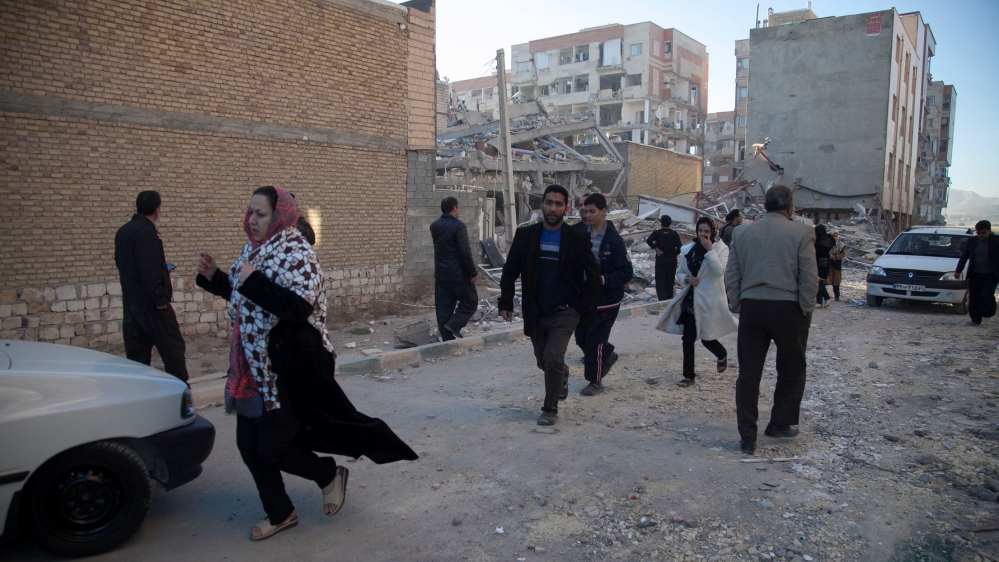 A magnitude 7.3 earthquake struck the border region between Iraq and Iran on Sunday evening (November 12). This has been the deadliest quake in the world this year.
A magnitude 7.3 earthquake struck the border region between Iraq and Iran on Sunday evening (November 12). This has been the deadliest quake in the world this year.
This is what we know:
What happened and where?
- Earthquake hit near Halabjah. At 9pm (18:18 GMT) local time in Iraq on Sunday, a magnitude 7.3 earthquake struck near the border with Iran. The impact was devastating and the tremor was felt across the region.
- The earthquake was felt as far as Kuwait , Qatar, Turkey, Lebanon, Israel and the United Arab Emirates.
- Eight earthquakes hit on Monday. More tremors struck near Halabjah and Khanaquin on the Iraqi side, and near Sarpol-e Zahab and Qasr-e Shirin in the Iranian province of Kermanshah.
- In Iraq, tremors were felt at 7am, 12pm, and 6pm. The strongest tremor was of magnitude 4.8.
- In Iran, tremors were felt at 12am, 3am, 7am, 11am, and 4pm. The strongest tremor was of magnitude 4.9.
- US Geological Survey said there were at least 150 aftershocks following the initial earthquake.
 |
Death toll
- The majority of victims were Iranian. IRNA, the country’s state news service, said on Monday that at least 413 people were killed and 7,370 were injured.
- Officials in Kermanshah said most of the Iranian deaths were in the town of Sarpol-e Zahab where 236 people died.
- At least nine people killed in Iraq. The Iraqi Red Crescent said that nine people were killed in Iraq’s northern province of Sulaimaniyah, and 425 people were injured there.
- No injuries in neighbouring countries. Although tremors were felt beyond Iraq and Iran, no injuries have been reported in the neighbouring countries.
Why did it happen? How often are there earthquakes?
- Being situated near a fault line, earthquakes are frequent in the region.
- The epicentre of the earthquake near Halabjah falls on the 1,500 kilometre-fault line between the Arabian and Eurasian tectonic plates. The fault line extends through western Iran and into northeastern Iraq.
- In 2012, two earthquakes hit north-west Iran killing 200 people, with more than 2,000 injured, near the towns of Tabriz and Ahar.
- In 2005, a magnitude 6.4 earthquake hit Iran’s Kerman province and killed more than 600 people.
- In 2003, a magnitude 6.6 earthquake flattened the historic city of Bam in southeastern Iran, killing some 26,000 people, 1000 km (600 miles) southeast of Tehran.
Is it safe now? How extensive is the damage?
- Risk of more tremors. Small magnitude earthquakes have continued to hit around the area. As of latest, at magnitude 4.6 earthquake hit Khanaquin in Iraq at 6:00pm on Monday.
- Emergency declared in Iraq. Officials in Sulaymaniyah declared an emergency on Monday to assess the aftermath, according to local Kurdish media.
- Residents were told to sleep outside their homes as precautionary measure. Iraq’s meteorology centre also advised people to stay away from buildings and elevators, in case of aftershocks.
- The most extensive damage was in the town of Darbandikhan, southern Sulamaniyah.
- More than 70,000 shelters needed. The Iranian Red Crescent said more than 70,000 people needed emergency shelter. It is “difficult to send rescue teams to the villages because the roads have been cut off … there have been landslides,” said Iran’s emergency services chief, Pir Hossein Koolivand.
- IRNA said 30 Red Cross teams had been sent to the quake zone.
- Several cities have been cut off from electricity, schools in Kermanshah and Ilam provinces closed, and three days of mourning have been announced.
- Oil pipelines and refineries in the area remained intact, an Iranian official said.
Reactions
- President Rouhani said: “I wholeheartedly sympathise with all the injured and the victims of this disaster, and ask the Almighty [for] mercy for those who lost their lives, swift recovery for the injured and patience and health for those fellow Iranians who lost their beloved one.”
- Turkey was the first country to offer aid through its Disaster and Emergency Management Presidency. It announced 92 rescue personnel were on standby, with 4,000 tents and 7,000 blankets.
- EU Foreign Policy Chief Federica Mogherini said the bloc was ready to cooperate with Iran in providing emergency relief aid.
- Pakistan also expressed its condolences.
- Russian President Vladimir Putin sent a message of condolences to his Iranian counterpart Hassan Rouhani. Russian Emergency Minister Vladimir Puchkov also sent messages of condolences and said they are ready to help the two countries deal with the consequences of the natural disaster.
- “The United Nations stands ready to assist efforts to respond to the deadly earthquake that struck Iran and Iraq on Sunday,” Secretary-General Antonio Guterres has said.
Source:-alzajeera






















